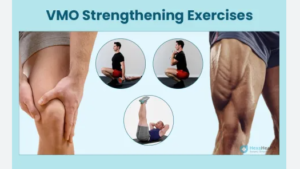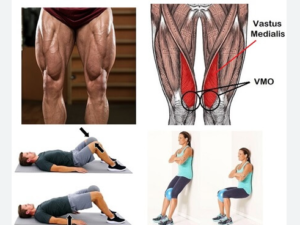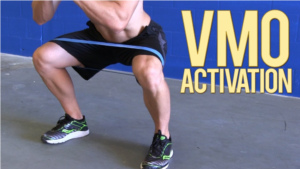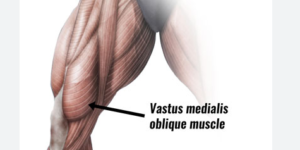Table of Contents
Are VMO Muscle exercises real:
For years surgeons, physical therapists, and amateur bodybuilders have been trying to activate, strengthen, and develop their VMO. Many individuals with pain at their kneecap or who are rebounding from a knee surgery are told to “target their VMO” during their rehab period. They call it the “teardrop” muscle of their leg. They try to isolate and grow it. A quick google search will disclose thousands of hits for the amazing exercises to target your VMO.
In this article we will learn about What is the VMO? What is your VMO, Why is everyone trying to aim for it? Can you actually isolate it and what is the best way to strengthen Vmo strengthening exercises?

vmo muscle
What is VMO ?
The Vastus Medialis Oblique is a part of your quadriceps muscle. Your quadriceps is made up of 4 different muscles in your thigh. It comes together at your quadriceps tendon to pull on your kneecap. It extends your knee, between other actions. These VMO muscles include the:
- Rectus Femoris
- Vastus Lateralis
- Vastus Intermedius
- Vastus Medialis
Quadriceps muscles VMO exercises:
Your Vastus Medialis (VMO) is further subdivided into the Vastus Medialis and Vastus Medialis Oblique. It is a long-winded way of saying your VMO muscle is just a part of one of the four muscles of your quad. So why does it get so much notice? Why does anyone think about the VMO muscle?
Why Talk About the VMO And Specifically VMO Exercises?
The VMO gets all this concentration because of the alignment of its fibers. It has the most oblique orientation of all the parts of your quadriceps. Since many in the orthopedic community have trust that kneecap pain or patellofemoral pain syndrome was the end of your kneecap not moving properly in the groove. They thought isolating the VMO would be the best way to fix it.
Are you Looking for a knees-over-toes program?
Importantly, are you having difficulty with knee over toes movements or exercises like going downstairs, squatting, or leaping? Our Rehab version of knees over toes programming is our Patellofemoral or kneecap joint Pain Program. This is because the kneecap tends to be the pain site or painful source when knee over toes exercises are not bearer. The trainers designed a 4 month program to improve your knee health and more importantly it improves your knees over toes capacity.
One another theory goes like this : your patellofemoral joint is like a train running on its tracks. Your kneecap is the train, and the trochlear groove of your femur is tracks. It results from an asymmetrical pull on your kneecap. It leads it to track laterally in the groove. This is credited to tight lateral structures such as a tight IT band and weak medial structures that is a weak VMO
So, your kneecap hurts because the IT band is pulling it laterally. while your weak VMO is not strong enough to pull it medially and keep it in the trench. So, you need to stretch your band and isolate your VMO right.
This seems to make a lot of sense, lots of research has shown that it is unlikely to be the case. It includes:
- Studies of young females with patellofemoral pain that were determined showed no changes in patellofemoral tracking.
- Taping designed to right the alignment of the patella helped with the pain but it did not change patella tracking as shown on MRI.
- The VMO atrophy was noted in patients with patellofemoral pain, but it was overall quadriceps atrophy.
So it seems that the kneecap pain may not be the result of patella maltracking. Your VMO is no more crucial than any of the other parts of your quadriceps in addressing the patellofemoral pain.

vmo muscle
Prehab Membership The Prehab Guys:
The Prehab membership is the anti-barrier solution to keeping you healthy. Access state-of-the-art physical therapy, fitness programs, and workouts in the comforts of your own home or gym. It takes control of your health with exercise and education from the palm of your hand has never been convenient. It has access to more than 50 programs, more than 100 unique workouts, and 3000+ exercises to make your own workout routines.
Can you Isolate the VMO Muscle with VMO Exercises?
It is a systematic review combining 20 different papers. It investigates whether or not we can isolate the VMO muscle with VMO exercises. These papers all used electromyography (EMG) to calculate the activation of different parts of the quadriceps during supposed VMO isolation exercises. Of these twenty papers, 17 found that you cannot even selectively activate your VMO. It alone isolates it. The author also found considerable flaws in the construction of the 3 studies that did find any proof for VMO preferential activation. The author concludes that:
“It is therefore suggested that clinicians should not focus on strengthening VMO, in preference to general quadriceps training when rehabilitating patients with patellofemoral condition, because this may not be possible”
For further support this claim, an anatomical study found that the VMO muscle may not even exist. Noting that the VMO muscle was not found to be truly independent of the other part of the vastus medialis (VML). Moreover, the nerves that activate the various parts of the vastus medialis are not independent. So, without independent neural innervation to your VMO muscle, you would not be able to independently activate your VMO muscle.
Exercises for Quadricep VMO Strengthening:
-
Single Leg Squat : Terminal Knee Extension:
The Spanish Squat as demonstrated here is one of the amazing exercises to truly target your quadriceps muscle. Trust it, after a few minutes of performing these exercises, your quads will be burning.
-
Anterior Step Down : Wedge
To more emphasis quadriceps Vmo strengthening, you should perform a squat motion on a wedge. This will force your knee in a controlled manner to advance over your toes. It allows for maximum quadriceps activation.
How To Do Vastus Medialis Exercises:
Vastus medialis and vastus medialis oblique are the main part of the same muscle so you do not need to do various exercises for each part. But, you do want to assure that VMO muscle is activating properly.
Squeezing a squashy ball between your knees as you do vastus medialis exercises really assists to make sure the VMO is switching on. A foam ball is best but if you do not have one, use a soccer ball, just make sure it has a bit of give in it by letting some of the air out from it.
We will start by looking at how to activate VMO and then look at a whole range of VMO exercises.

vmo muscle
VMO Activation:
VMO Exercises: How to activate the VMO?
Sit upright in a chair, with your knees bent, and ball between your knees and your feet flat on the floor. Place your thumbs on the Squashy area on the inner side of the knee, just above your kneecaps and press down strongly.
Clench your gluteal muscles and softly squeeze the ball. Making sure that the movement comes from your knee rather than the inner thigh.
You feel a tightening or swelling underneath your thumbs. It shows you that you are activating vastus medialis and the VMO. That is the area we want to make sure is doing with all the exercises
If you cannot feel it, try squeezing your buttocks, clenching your knees and squashing the backs of your thighs down into the chair.
Test both sides together, specifically if you have knee pain or swelling, you may well notice a complete difference between sides.
Ball Clench Extensions:
Inner Range Quadriceps VMO Strengthening.
- Lie on your back with a rolled up towel and underneath your knees and place the ball between your knees.
- Clench your buttocks and softly squeeze the ball, then lift one heel off the ground until your knee is straight.
- Keep clenching the ball and grasp for 3 seconds then it slowly lower the foot back down.
- Repeat about ten times and gradually increase the number of reps as you get stronger. It is aiming to get up to 25.
Twisted Leg Raise:
Vastus Medialis Exercises: Twisted Leg Raise to partially VMO.
- Recline on your back with one leg stretched out straight and the knee bent. This takes the tension off the lower back as you are doing the straight leg.
- Turn your foot outwards about twenty into external rotation. Then lift the foot up until the thighs are parallel.
- Hold for just three seconds and slowly lower down. It keeps the foot turned outwards
- Keep the leg turned outwards in this VMO exercise. It again helps to activate the VMO muscle.
Ball Bridges:
Vastus Medialis Strengthening Exercises – VMO Ball Bridge.
- Recline on your back with your knees bent. It feet hip distance apart and ball between your knees.
- Stretch your glutes, softly squash the ball and lift your bottom up as high as you can without arching your back.
- Hold for three seconds and slowly low down.
- Keep flattening the ball and clenching your glutes throughout.
- You can make the exercise tough by looping a resistance band over your hands and you anchor down with your hand.
Ball Wall Squats
Vastus Medialis Strengthening – Wall Ball Squats
- It stands with your back against a wall and a squashy ball between your knees. It heels about 6 feet away from the wall, and toes pointing forwards.
- Contract your glutes and softly squash the ball to activate VMO. Then slowly slide down the wall and bend your knees.
- Slide down the knee as far as you feel in control, hold for three seconds and slowly push yourself back up.
- Keep your glutes and the ball pawed throughout.
Vastus Medialis Stretch:
- Stand to hold a chair or the wall for balance. Bring your heel back up. Grab your ankle and pull your heel towards your buttock, until you feel an extent without bending forwards.
- This will stretch all four of the quads muscles but you can partial the stretch towards the VMO muscle by moving your foot across your body towards the buttock.
- Raise the stretch by pushing your hips forwards as you do the exercises. Hold for thirty seconds and repeat 3 times. Do not bounce on and off the stretch. It is much more effective to hold the stretch. For more amazing tips on stretching, visit the knee stretches videos.
Advanced VMO Exercises:
Once you can do thirty reps of each of these vastus medialis exercises with good control. It feels confident that you are activating your VMO. You can go onto more advanced exercises like lunges, step ups and step downs without requiring the ball.

vmo muscle
What Exercises Else Can Help:
VMO exercises are the best way to improve knee strength, stability and endurance. It can really help to decrease knee pain. To be more effective, they should also be linked with strengthening and stretching exercises for the other knee muscles:
- Knee Strengthening Exercises
- Quads Strengthening
- Hamstring Strengthening
- Glute Strengthening
- Resistance Band Strengthening
- Knee Stretches
- Quads Stretches
- Hamstring Stretches
- Glute Stretches
- ITB Stretches
More info: A Complete Overview of the Different Types of Moles 2024
Conclusion:
Isolating the VMO has long been viewed as the holy sangraal of patellofemoral pain rehab. Recent evidence has shown that theories supporting this, including the idea of patella maltracking, are not supported by research. The news is that we know isolated quadriceps strength can be attained. This improving quad strength and size will improve strength, size as well. We also know that a robust quadriceps strengthening program is one of the amazing things that we can do to improve patellofemoral pain syndrome. So, train your quads and you will be training your VMO muscle.
FAQs:
What happens if your VMO is not strong?
The other quadriceps pull the kneecap to the part outside of the groove.
What is the purpose of VMO?
It is one of four quadriceps muscles. Your VMO sits medially or on the inner side of your thigh. Its function is to extend the knee.